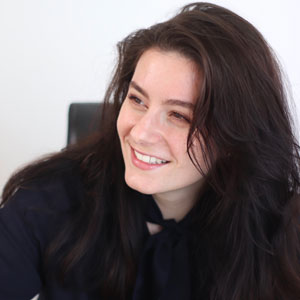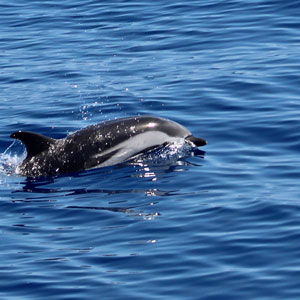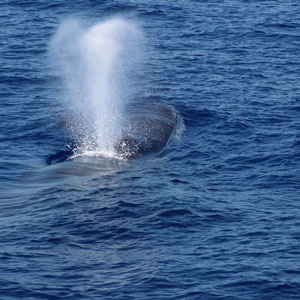For Anaïs Remili, a PhD candidate researching the impacts of environmental contaminants on killer whales, there was at least one upside to last year’s pandemic shutdown. She and a friend found time to create a science communications website they had long dreamt about.

Whalescientists.com is designed to help people learn about marine mammals and to share helpful information with other early-career researchers. Since its launch in May 2020, the site has attracted over 200,000 visits. Young scientists around the world have signed up as contributors.
The site’s visibility has also enabled Remili to connect with a wider audience. When a humpback whale captured media attention by wandering up the Saint Lawrence River to Montreal last year—much farther from the ocean than whales usually travel—Remili helped explain the phenomenon through media interviews and an article she wrote for Québec Science magazine.
Orcas’ shifting diets
Remili’s doctoral work focuses on killer whales—also known as orcas—in the North Atlantic. In March, she was lead author on an article in Environmental Science and Technology showing that some Icelandic orcas have concentrations of PCBs (polychlorinated biphenyls) in their blubber that surpass all known thresholds for risks of health effects.
PCBs are industrial chemicals that were banned from production decades ago, after they were found to affect the health of both humans and wildlife. But because they degrade very slowly after being released into the environment, they are still ubiquitous and accumulate in the bodies of marine mammals. And since killer whales are at the top of the marine food chain, they are among the most contaminated animals on the planet.
Icelandic orcas mainly eat fish, but some “pods”—small groups that travel together—appear to have “adjusted their dietary strategies” by learning to prey on seals as well as fish, Remili explains. Her study, authored with Prof. Melissa McKinney of the Department of Natural Resource Sciences, determined that the orcas with mixed diets have up to nine-times-higher levels of PCBs—far more than previous research had suggested.
In the next phase of her research, Anaïs is looking at fatty acid “signatures” in the blubber of killer whales throughout the North Atlantic, to get an indication of the composition of marine-mammal and fish prey in their diets.
“This study reveals a previously overlooked, but critically important, aspect of killer whales' remarkably high exposures to these substances; that is, differences in prey specialization between individuals within just a single population can lead to markedly different levels of contaminants,” says Prof. McKinney, who holds the Canada Research Chair (Tier 2) in Ecological Change and Environmental Stressors. “What this means is that we must take individual ecology into consideration to really understand the population-level threats posed by environmental contaminants to these sensitive marine mammals.”
Childhood fascination leads to global journey
Remili, who grew up in the French Alps, became fascinated with whales as a kid. “It might have started with watching films like Free Willy,” she says. “Every family trip that we took that brought us close to the sea, I was so excited and I just wanted to go see dolphins and whales.”

After a year as a high school exchange student in Michigan, she completed an undergraduate degree in biodiversity in France and did a summer internship with a foundation in Italy, helping with research on marine mammals in the Mediterranean.
She went on to earn a Master’s degree in Marine Environment Resources through Europe’s Erasmus Mundus program, with coursework at universities in Belgium, Bordeaux and the Basque country of Spain.
In Spain, she was introduced to “ecotoxicology”—the study of the effects of toxic substances in ecosystems. “I fell in love with the idea of researching pollutants and toxicology,” Remili says. “I decided that’s what I wanted to focus on.”
She also did a summer internship with a University of Louisville lab studying the effect of chromium on the cells of humpback whales; that stint included a few weeks collecting whale biopsy samples in the Gulf of Maine.
Back at l’Université de Liège in Belgium, one of her professors suggested using blubber samples from Antarctica to do a thesis on pollutants in humpback whales of the southern hemisphere. She did so, and completed her Master’s thesis after a year in Belgium, shuttling to Antwerp to conduct some of the analyses in a specialized lab there.
Remili won the award for best thesis in her program, as well as ranking first based on coursework.
A McGill connection
Anaïs hoped to continue working on whale ecotoxicology in a PhD program. But very few labs in the world focus on that, so finding the right opportunity presented a challenge. She reached out to postdoctoral researcher Jean-Pierre Desforges, whom she had met in Denmark. He connected her with Prof. McKinney, who had recently been hired at McGill and was looking for a PhD student.

“I thought this was really a one-time opportunity, and I knew it was going to be with contaminants and top predators,” Remili recalls. “When I found out I would be working on contaminants in North Atlantic killer whales I was over-the-moon excited. It was my dream project.”
She scrambled to get her study permit, just in time to move to Montreal and start at McGill in January 2019.
Early on, McKinney suggested that Remili also collaborate with Robert Letcher at Environment and Climate Change Canada who had been McKinney’s own PhD advisor. Letcher, a well-known specialist in the field, is now co-supervising Remili’s work. He and Desforges, now a postdoctoral fellow at McGill, were co-authors on the recent paper by Remili and McKinney on Icelandic orcas.
Communicating science, in two languages
Like many other young scientists, Remili has discovered that sharing knowledge with the public is not only rewarding in its own right—it also helps researchers think hard about why their work matters to people other than specialists in their field.

Soon after coming to McGill, Anaïs participated in a workshop for young researchers at the Macdonald campus, with McGill communications officers providing tips on how to make scientific papers accessible to a general audience.
Remili tried her hand at a science popularization contest, sponsored by the Institut Nordique du Québec, where grad students present their Arctic research project in five minutes. She won the Quebec contest (en français) and went on to win the international final of the competition (in English) at the Arctic Circle Assembly in Reykjavik, Iceland. “That really started my scientific communication journey,” she says.
With the support of the interuniversity Quebec Centre for Biodiversity Science, she also won a Fonds de Recherche du Québec grant for science communication, to fund a documentary about her orca research in Iceland. Filming was planned for this summer; but with pandemic travel restrictions still in effect, “it looks like the timetable has been pushed back a bit,” she says.
An ‘amazing’ city
While she looks forward to traveling again, Remili is happy to be studying here. “Montreal is amazing,” she says. “It’s one of the best cities I’ve lived in—and I’ve lived in a lot of cities.”
Remili’s high school exchange program in Michigan enabled her to become flawlessly bilingual, which “opened a lot of doors” for her. Montreal offers similar possibilities for international students, she notes. “It’s a great opportunity to learn or practice French as a second language.”
Watch Anaïs explain her orca research in a recent webinar hosted in British Columbia.

